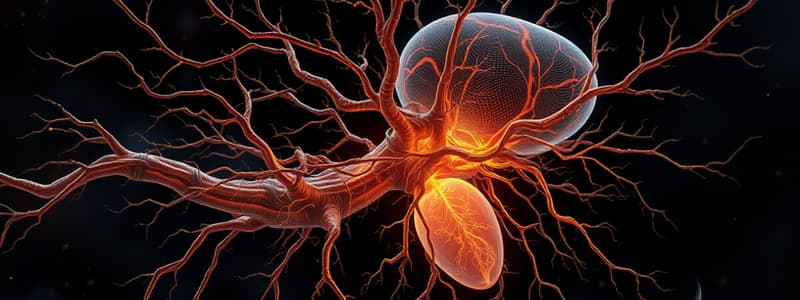Podcast
Questions and Answers
Which of the following is NOT a derivative of the ectoderm?
Which of the following is NOT a derivative of the ectoderm?
- Adrenal medulla
- Sensory epithelium of the ear
- Chondroblasts of facial skeleton (correct)
- Peripheral nerves
What is the first step in the development of the central nervous system?
What is the first step in the development of the central nervous system?
- Specialization of cells at the neural fold margin
- Formation of the neural tube
- Elevating of the neural folds
- Change of flat ectodermal cells into columnar cells (correct)
At which day does the cranial neuropore close during neurulation?
At which day does the cranial neuropore close during neurulation?
- 30th day
- 23rd day
- 27th day
- 25th day (correct)
What stimulates neurulation during the formation of the central nervous system?
What stimulates neurulation during the formation of the central nervous system?
Which cells are produced from neural crest derivatives?
Which cells are produced from neural crest derivatives?
What is the fate of the lens placode during development?
What is the fate of the lens placode during development?
Which sequence correctly describes the formation of the neural tube?
Which sequence correctly describes the formation of the neural tube?
Which of the following is specifically derived from the neural crest?
Which of the following is specifically derived from the neural crest?
Flashcards are hidden until you start studying
Study Notes
Derivatives of Ectoderm
- Central nervous system (CNS) originates from the ectoderm.
- Neural crest forms from the lateral edges of the neural plate.
- Otic placodes develop into the internal ear structures.
- Lens placodes contribute to the formation of the eye's lens.
- Other ectoderm derivatives include peripheral nerves and sensory structures.
Formation of CNS (Neurulation)
- Induced by growth factors secreted by the developing notochord, facilitating neural development.
Steps in CNS Development
- Neural Plate:
- Formed by transformation of flat ectodermal cells into columnar cells.
- Neural Folds, Groove, and Crest:
- Lateral edges of the neural plate elevate into neural folds.
- The neural folds diverge, creating a neural groove.
- Specialized cells at the folds’ margins form neural crests, which fuse above the neural tube and later split into two columns.
- Neural Tube Formation:
- Cranial neuropore at the tube’s head closes by the 25th day.
- Caudal neuropore at the tail end closes by the 27th day.
- Remaining ectoderm fuses above the neural tube and crests to form surface ectoderm.
Derivatives of Neural Crest
- Neural Cells:
- Include sensory and autonomic ganglia, adrenal medulla, Schwann cells, and glial cells.
- Pigment Cells:
- Produce melanocytes found in the skin and iris.
- Secretory Cells:
- Parafollicular C-cells of the thyroid gland arise from neural crest cells.
- Mesenchymal Cells:
- Chondroblasts, osteoblasts of facial skeleton, myoblasts, fibroblasts, and odontoblasts contribute to various tissues, including tooth dentin.
- Arachnoid and Pia Mater:
- Laminated layers surrounding the brain and spinal cord.
- Aortico-Pulmonary Septum:
- Forms between the ascending aorta and pulmonary trunk.
Placodes
- Otic Placode:
- Gives rise to structures within the internal ear.
- Lens Placode:
- Develops into the lens of the eye.
Other Derivatives of Ectoderm
- Peripheral nerves originate from ectodermal cells.
- Sensory epithelium develops for the eye, ear, nose, and tongue.
- Sensory nerve endings are present in the epidermis of the skin.
- The pituitary gland derives from ectoderm.
- The anterior part of the oral cavity also originates from ectodermal tissue.
Studying That Suits You
Use AI to generate personalized quizzes and flashcards to suit your learning preferences.



